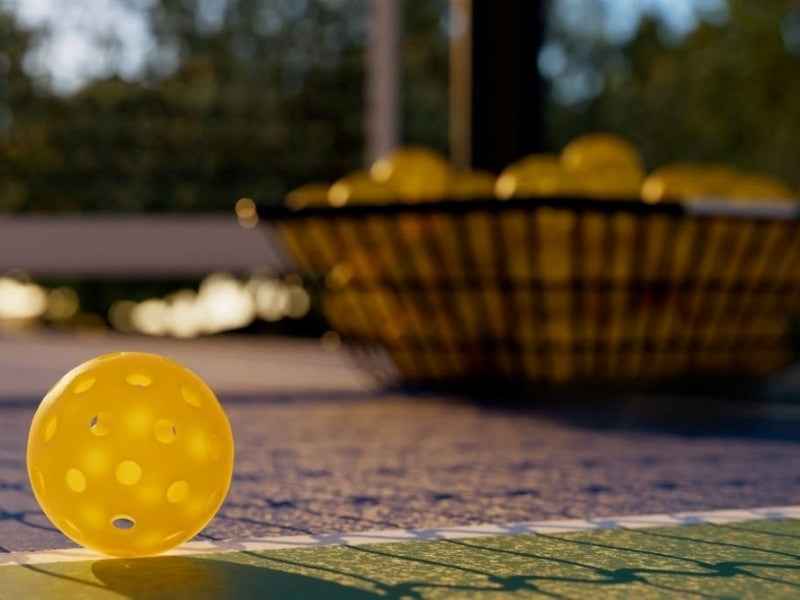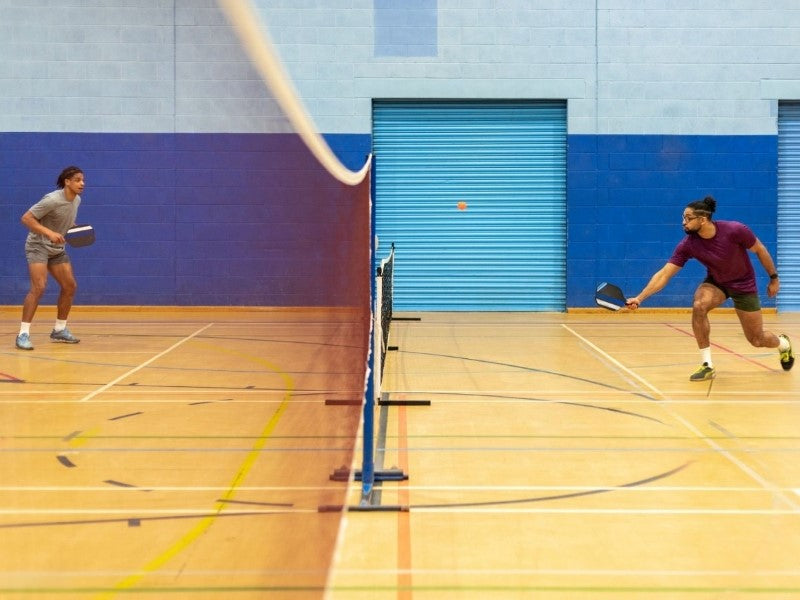Pickleball may look like a simple paddle sport, but every detail of its equipment — especially the ball — plays a huge role in the game’s speed, control, and overall feel. While most players know that a pickleball is “made of plastic,” far fewer understand the specific types of plastic, how they are manufactured, and how these materials impact performance.
What Is a Pickleball Made Of?
A pickleball is typically made from durable, lightweight plastic polymers designed to withstand repeated impact while maintaining consistent bounce and flight patterns. The most common materials include:
- Polyethylene (PE) — Flexible and impact-resistant, often used for indoor balls.
- Polypropylene (PP) — Stiffer and more weather-resistant, common in outdoor balls.
- Composite blends — Mixing polymers for a balance of softness, durability, and speed.
While all pickleballs look similar — hollow, perforated spheres — the material choice determines their weight, bounce height, and feel.
Indoor vs Outdoor Ball Materials
The material composition differs depending on where you play:
- Indoor Pickleballs are often made with softer PE blends for better control and reduced noise on gym floors.Outdoor Pickleballs use harder PP or composite plastics for improved crack resistance in varying temperatures and rougher surfaces like asphalt.
This difference isn’t just about durability — it changes how the ball reacts to your paddle, the spin you can generate, and even your strategy on the court.
Pickleball Manufacturing Process
Creating a pickleball isn’t as simple as molding a hollow sphere. High-quality manufacturing involves several precise steps to ensure the ball meets performance standards.
1. Injection Molding
- Plastic pellets are melted and injected into a mold to form two identical halves of the ball.
- These halves must be perfectly round to ensure accurate flight.
2. Joining the Halves
- The two halves are heat-welded or ultrasonically fused together, creating a seamless joint.
- Poor welding can lead to cracks during play.
3. Drilling the Holes
- A specialized machine drills evenly spaced holes (26 for indoor, 40 for outdoor) with precise diameters.
- The hole pattern directly impacts aerodynamics and stability.
4. Surface Finishing
- The ball’s surface may be polished or textured to influence grip and control.
5. Durability and Bounce Testing
- Each batch is tested for weight, diameter, bounce height, and roundness to meet USA Pickleball standards.
Material Types in Detail
1. Polyethylene (PE)
- Pros: Flexible, softer feel, quieter impact, better for indoor play.
- Cons: Less crack-resistant outdoors, especially in cold temperatures.
- Performance Impact: Allows for more control and spin, ideal for rallies where placement matters more than speed.
2. Polypropylene (PP)
- Pros: Highly durable, weather-resistant, retains shape longer under heavy use.
- Cons: Slightly harder on the paddle, can be noisier.
- Performance Impact: Provides a faster game pace and reduced wind interference outdoors.
3. Composite Polymers
- Pros: Customizable blend of flexibility and hardness, designed for specific performance goals.
- Cons: Often more expensive, with variations between manufacturers.
- Performance Impact: Balances control and power, making them versatile for mixed indoor/outdoor play.
4. Recycled Plastics
- Pros: Environmentally friendly, reduces manufacturing waste.
- Cons: May have inconsistent performance if not processed carefully.
- Performance Impact: Becoming popular for recreational use, but still rare in pro-level balls.
How Material Affects Performance
The material of a pickleball directly determines speed, bounce, spin potential, durability, and feel. Here’s how:
1. Speed and Bounce
- Harder plastics like polypropylene create faster, livelier balls that bounce higher.
- Softer plastics like polyethylene reduce bounce speed, allowing for longer rallies.
2. Spin Potential
- A slightly textured surface or softer plastic grips the paddle face better, giving players more control over topspin and backspin.
- Outdoor PP balls with smooth finishes are harder to spin but travel straighter.
3. Durability
- Outdoor games on rough courts demand a ball that resists cracking. PP performs better here.
- Indoor PE balls last long on smooth courts but wear down faster outdoors.
4. Temperature Sensitivity
- Cold temperatures make plastics brittle; PP handles this better than PE.
- In hot conditions, softer plastics can warp slightly, affecting bounce consistency.
Regulation Standards for Pickleballs
Whether you play in a local club or at a national tournament, USA Pickleball Association (USAPA) standards define what makes a ball “official”:
· Diameter: 2.87–2.97 inches (73–75 mm)
· Weight: 0.78–0.935 ounces (22–26.5 g)
· Bounce Height: 30–34 inches (76–86 cm) from a 78-inch drop on a granite surface
· Hole Count: 26 (indoor) or 40 (outdoor), evenly spaced
· Color: Any solid color, but neon shades are preferred for visibility
· Surface: Smooth, with no texturing that unfairly increases spin
If a pickleball fails these standards, it cannot be used in sanctioned competitions.
Indoor vs Outdoor Balls: Performance Breakdown
|
Feature |
Indoor Pickleballs (PE) |
Outdoor Pickleballs (PP) |
|
Material |
Softer polyethylene |
Harder polypropylene |
|
Hole Count |
26 |
40 |
|
Durability |
Moderate |
High |
|
Bounce Control |
High |
Medium |
|
Wind Resistance |
Low |
High |
|
Noise Level |
Low |
Higher |
|
Spin Potential |
High |
Medium |
Common Myths About Pickleball Materials
Myth 1: All pickleballs are the same.
Reality: Even two balls made of the same polymer can feel different due to mold precision, hole pattern, and welding quality.
Myth 2: Indoor balls can be used outdoors.
Reality: You can, but you’ll notice faster wear, cracks, and inconsistent bounce.
Myth 3: Softer balls are always better for beginners.
Reality: Beginners may benefit from the stability of outdoor PP balls, especially in windy conditions.
Choosing the Right Pickleball for Your Game

1. Match Ball Type to Court Surface
- Gym floors = softer indoor balls.
- Asphalt/concrete = harder outdoor balls.
2. Consider Your Playing Style
- Players who prioritize control might opt for softer balls to enhance their touch.
- Power hitters benefit from harder balls that produce faster volleys.
3. Factor in Local Climate
- If you play in cold weather, choose a crack-resistant polypropylene ball.
4. Test Before You Buy in Bulk
- Small performance differences can significantly affect your comfort level.
Environmental Impact and Sustainability in Pickleball Manufacturing
With pickleball’s rapid growth, ball production has scaled up — raising questions about sustainability. Some manufacturers are experimenting with:
· Recycled polymer blends to reduce raw material use.
· Biodegradable plastics for recreational balls (still in development).
· Closed-loop manufacturing where defective balls are remelted and reused.
Eco-conscious players may soon have more green choices without sacrificing performance.
Maintenance Tips for Longer-Lasting Pickleballs
· Avoid extreme temperatures: Store indoors when not in use.
· Rotate your balls: Alternate between several to prevent uneven wear.
· Clean periodically: Dirt buildup can affect aerodynamics.
· Inspect for cracks: Replace at the first sign to maintain consistent play.
A pickleball is much more than “just a plastic ball.” The choice of material, manufacturing precision, and even hole design directly influence game speed, spin, and durability. Whether you’re selecting balls for casual weekend games or preparing for competitive play, knowing what a pickleball is made of empowers you to make the right choice for your playing style, court type, and climate.
As technology advances, we may see even more specialized materials that push performance further — maybe even eco-friendly balls that meet pro standards. Until that time, your strongest performance begins with selecting the ideal ball for what you require.










Leave a comment
This site is protected by hCaptcha and the hCaptcha Privacy Policy and Terms of Service apply.